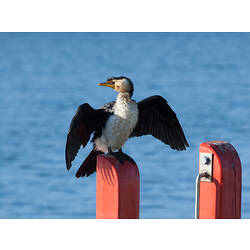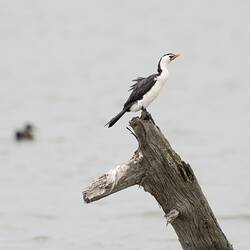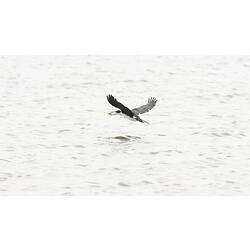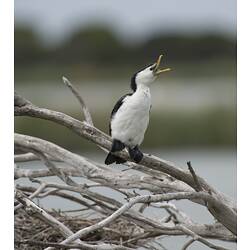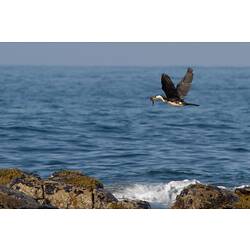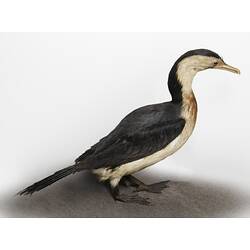General Description
Little Pied Cormorants are black above and white below. They have a small crest of black feathers in front of the bill. The bill is yellow with a slightly hooked tip. The feet are webbed and the tail is long and wedge-shaped. Little Pied Cormorants are the smallest of the five species of cormorant found in Australia. The bill to tail length is up to 55 cm.
Biology
Little Pied Cormorants hunt by making short, shallow dives from the surface of the water. They feed on a wide variety of aquatic animals, from insects to fish. Claws are shaken off freshwater crayfishes before they are swallowed. After diving, cormorants often perch with their wings out to the side to help their feathers dry. These cormorants breed in colonies, commonly with other waterbirds including other cormorant species, spoonbills, herons and ibises. Each nest is a platform structure about 30 cm across, usually in the fork of a tree, on bushes or on an artificial structure such as a disused jetty.
Distribution
New Zealand and Pacific Islands. Mainland Australia and Tasmania.
Habitat
Wetlands, including swamps and coastal bays.
More Information
-
Animal Type
-
Animal SubType
-
Brief Id
A black and white waterbird with a stubby yellow bill and a long wedge-shaped tail. Often perches with wings held out to the side.
-
Colours
White, Black, Yellow
-
Maximum Size
55 cm
-
Habitats
-
Diet
Carnivore
-
Diet Categories
Fish, Invertebrates
-
Endemicity
-
Commercial
No
-
Conservation Statuses
CITES: Not listed, FFG Threatened List: Not listed, EPBC Act 1999: Not listed, IUCN Red List: Least Concern
-
Taxon Name
-
Common Name
Little Pied Cormorant
-
Kingdom
-
Phylum
-
Subphylum
-
Class
-
Order
-
Family
-
Genus
-
Species Name
melanoleucos

